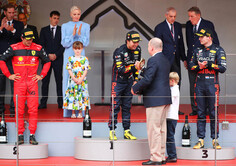 The Monaco Grand Prix is always a hit and miss race.
The Monaco Grand Prix is always a hit and miss race.
If there are accidents, the resulting safety cars and red flags help to mix up the running. However, if there aren't any, like we saw in 2021, then it can become incredibly processional with the drivers struggling to find room to overtake their rivals.
Rain can also have this effect. In 1996, a wet Monaco race led to Olivier Panis picking up his first and only F1 victory after several big names struggled and retired.
2022 also gave us a wet Monaco Grand Prix with thrills and spills right from the get-go. After an hour's delay, the race started from behind the safety car, but we saw both Nicholas Litifi and Lance Stroll crash their cars before the green light had even been lit.
For many F1 fans though, the wait enforced by Race Control ahead of the race seemed pointless and farcical, especially as the rain stopped and the sun came out.
Commentating for Sky Sports and the global syndicated English feed, Martin Brundle and David Croft spent much of the delay asking why the Race Director had not sent the safety car out to test the track conditions.
A lot of fans were having flashbacks to the Belgian Grand Prix at Spa last season when the race didn't truly get underway because of an unrelenting torrent of rain that left the race track looking more like a river that snakes through the Ardennes forest.
In some ways, what we saw in Monaco was the opposite of what happened in Belgium. Instead of Race Control trying to start a race in impossible conditions, they chose not to start it for some time while the conditions would have allowed running.
So why did this happen and what lessons can be learned?
 F1 Rules
F1 Rules
All sports have rules; they're necessary to ensure safety and fair competition. The rules need to be followed in their entirety as, otherwise, they might as well not exist in the first place.
In a lot of sports, the rules are quite simple to understand. For example, poker rules define several key elements like the order of hand rankings and the sequence in which players must place bets in rounds. They're simple to understand, even for beginners. So simple, in fact, that they fit onto just a few pages. Even football, which has an official FIFA rule book titled Laws of the Game, is pretty simple to understand. While this publication is 228 pages long, 94 are dedicated to VAR, quality management, a glossary, and guidance on teamwork and body language for match officials. The formatting also inflates the page count greatly and much of the rules refer to the dimensions of pitches, goals, and the like, something that most players and fans don't need to concern themselves with.
However, Formula 1 is governed by a very complicated set of rules and regulations that dwarf even football's Laws of the Game. There are three main documents used for policing the sport:
• The Sporting Regulations
• The Technical Regulations
• The Financial Regulations
These documents are much denser and combine to make a total of 356 pages that need to be read in parallel to the FIA's Practice Directions document.
The Financial Regulations refer to how much teams can spend - and on what - within a single season, ensuring that the cost cap is not exceeded. Meanwhile, the Technical Regulations define how the cars can be designed.
 It is the Sporting regulations that describe the procedures that must be followed during the weekend, such as when flags should be waved, how and when to deploy the safety car, and how Grands Prix are started.
It is the Sporting regulations that describe the procedures that must be followed during the weekend, such as when flags should be waved, how and when to deploy the safety car, and how Grands Prix are started.
During rain, the rules are quite prescriptive so a delay under the Monaco conditions was almost certainly inevitable. Since the rain came down right before the scheduled start, the use of intermediate tyres was necessary, so a delay was needed to allow teams to make the changes.
However, during the delay, the rain got heavier, necessitating a safety car start and, therefore, full wet tyres.
New Race Directors
The role of Race Director has garnered a lot more attention in recent years than we have ever seen before. We all know about the incident that resulted in Michael Masi being replaced after the end of last season.
Despite the controversy, Masi was much more experienced at handling wet races than Eduardo Freitas and Niels Wittich. Although they are seasoned Race Directors, the pair haven't yet dealt with a heavy downpour in F1.
This, reportedly, led to a disagreement between the two. The consequence of which was that drivers, teams, and fans went quite some time without receiving any messages about what was going to happen.
Eventually, racing did get underway with a rolling start after two laps behind the safety car - and what a race it was. While we may disagree about the calls made by the powers-that-be, the race itself was an exciting one from (the eventual) start to finish.























